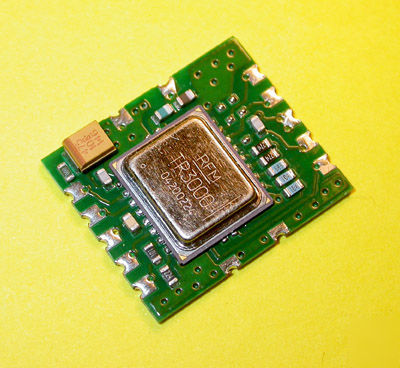Chicago Industrial Reuse and Parts Blog-Newsgroup > West Chicago
> New
> Agricultural
> Engines
> Rf monolithics DR3100 433MHZ 115KBPS transceiver
Rf monolithics DR3100 433MHZ 115KBPS transceiver
RF Monolithics DR3100 433MHz Transceiver
Complete two way UHF data radio - small as a thumbnail!
On offer are a number of individually priced DR3100-1 transceiver boards from RF Monolithics, new in factory bags. Part of RFM's "Virtual Wire" technology, these are highly integrated subsystems, suitable for 'licence free' ISM data communication over a short distance (30..300 feet) on 433.92MHz.
They are not the same as the crude little (MOPA) SAW keyfob transmitters; these are complete high performance 2-way data radios. What's more they are not bare fiddly SMD components, but complete modules with all support passives and the main surface mount transceiver mounted on a small PCB. All you have to do is connect power (2.5v .. 3.3v) an aerial (antenna) and wiggle/read the tx/rx data lines at up to 115kBPS.
* Integrated RF IC with quartz SAW filtering and frequency control components in a single hybrid
* High Data rates for data, control and digitized voice transmissions
* Stable, sensitive receiver technology with excellent "channel capture" performance
* Ultra Low current consumption for operation from small 3 V batteries
* Very small, low-profile package to make "watch size" applications practical
* Rugged, self-shielding, metal-ceramic hybrid package
* Wide operating temperature range for industrial and outdoor applications
* Easy to optimize for a wide range of application requirements
* Easy certification to stringent short-range radio regulatory requirements
* No external RF filters, IF filters, resonators or crystals are required
Being current production devices, full info is online ...
http:// /products/data/dr3100-1.pdf
ASH Transceiver Designer s Guide:
http:// /products/apnotes/tr_des24.pdf
Antenna Matching application note:
http:// /products/apnotes/antennamatch.pdf
As you can see from the schematic above they're simple to use. Coupled with your favourite micro, PIC, AVR, ARM, MSP430 ... think of the possibilities - a remote control handset with a display. Read telemetry data and send control signals to your 'bot' over the same link. Check the temperature in the shed or greenhouse at the bottom of the garden before deciding to turn on a heater or open a vent ... without leaving the house. I'm sure you can do better ...
Of course, I probably shouldn't suggest that the 5W UHF PA modules I'm also selling would increase their range hugely, or that the 1.2mW @ 50 ohms from these modules is exactly what those PA modules need for full output ... unless you're a licensed Ham (who may well be annnoyed at the ISM users right inside the 70cm Ham band anyway).
Applications suggested by the manufacturer include:
* Wireless automatic utility meter reading systems
* Communications links for hand-held terminals, HPCs and PDAs
* Wireless keyboards, joysticks, mice and game controls
* Portable and field data logging
* Location tracking (follow-me phone extensions, etc.)
* Sports and medical telemetry
* Surveying system data links
* Polled wireless security alarm sensors
Now, if you've a software background you might be interested in why I got hold of these nice parts. A couple of years back my interest was piqued by Motes, remote wireless sensors which form a network between themselves. The main research seemed to be happening at Berkeley (see http://webs.cs.berkeley.edu/, on the way to realising Smart Dust .
Being a university research program, the information is all published in the public domain, which has lead to a large number of 'affiliates' and related work, both research and commercial across the globe. The range of applications is huge - robotics, security, environmental monitoring, tracking, control systems ... the list goes on. Of course, there are big military applications for this technology which undoubtedly helped it get financed (like the Internet itself). An excellent demo was when a bunch of motes were dropped from a plane over a 'battlefield', allowed to collect data on enemy activity for a day, then interogated from a second plane doing a flight over the area 24 hours later. No need to land and locate them in order to pick up intelligence. Not that I'm a military fan, but this was 'mondo cool' ;-)
Best of all, the software base is Open Source, available for the price of a download. TinyOS (http://www.tinyos.net/) is a complete development/operating system for these small wireless devices, runs on Windows & Linux PCs. Programming is in NesC, a C based language with extensions).
The most impressive part for me is a database interface (TinyDB ... http://telegraph.cs.berkeley.edu/tinydb/) which allows the whole network of motes to be queried simultaneously, SQL style, without concern for where the data is actually generated and held.
A key requirement is that the sensors themselves should be small and cheap. The 'Mica' motes developed at Berkeley use the TR1000 transceiver ... the same basic part as the DR3100 here but working on the US ISM band at 916MHz, coupled with an Atmel AVR ATMega micro and very little else. Full schematics from the hardware page at http://www.tinyos.net/scoop/special/hardware (eg. http://webs.cs.berkeley.edu/tos/hardware/design/ORCAD_FILES/MICA/Mica_sch.pdf )
Unfortunately the cost of motes from the commercial manufacturers is IMHO still too high for an experimenter's budget, often hundreds of dollars. When I managed to get hold of a useful quantity of these transceivers well below regular retail price, as usual I bought more than I needed so I could share the opportunity, hence this listing!

